Re-dazzling the Basque media
- On the occasion of the centenary of ARGIA I was asked for an article for the publication Euskonews de Eusko Ikaskuntza. There it was published last week and now here. A medium of communication is rarely one hundred years old and we are happy to look at the past, feeding the memory of Basque journalism. In the following lines, however, it focuses mainly on progress, focusing on the contents that are the raw material of journalists. Below is a reflection on the Basque media and free licences.

It's been 31 years since I went to the first ARGIA meeting in early 1988 at a bar in the Casco Viejo de Bilbao. If I am not mistaken, Iñaki Uria came from the wording of San Sebastian. In Bilbo, we started collaborating in ARGIA with the group that was learning journalism. Who would tell me that in three decades the magazine would continue to work at the time of its centenary. One of my biggest obsessions when I was appointed director of ARGIA in the fall of 2001 was: “What if this that began in 1919 sinks with me?” Of course, these thoughts originated in the severe moments in which they had lived for so many times. Disappear? Well, except when it was the germ of a newspaper, the magazine reaches its centenary in the strongest time I've ever known.
Throughout this time this Weekly has given me the perfect watchtower to follow the Basque media and from there we see the great leap we have made in the media. This advance could hardly be understood without taking into account the work carried out by the hargiers in the 1980s, without, fundamentally, taking into account the chain eyes that came from the early 20th century: Zeruko Argia religious magazine founded in 1919 by two Capuchins in a convent of the Rochapea of Pamplona: The Semanario ARGIA, started in 1921 in San Sebastian, which under the protection of the Capuchin placed the pillars of Basque journalism in the 1960s or the innovative and rebellious writing of Zeruko Argia in the 1970s.
Memory is also At the bottom
of the future memory is essential in any area, so it is better for us to do it, for others to do it. And Zeruko Argia and ARGIA are the backbone in the memory of the Basque press. This year we are working on the preparation and dissemination of this report to the entire ARGIA team.
But despite the importance of the past, we live in the present and in the future. Euskaldunon Egunkaria, internet, multimedia, social networks, information sovereignty, Hekimen, voluntary price subscription, free license... Our significant copy that we have put into all these areas at every moment clearly indicates this.
Sharing information between the Basque media reinforces our Basque information agenda. We talk little about the agenda and that is worrying
They are aware of the complex reality of the Basque media, where we were and where we are! If we don't get that recognition, who's going to do it? Well, what I have not heard all these years from the poor quality of the Basque media, from our scarce ability to attract consumers or from our dark future – “you have four magazines” – but from encouragement, all aimed at thickening our complexes, sometimes with the best will and sometimes with the worst.
But we entered the post-modernity, the internet appeared, and the crisis of 2007... and in the Castilian media appeared the orthotized dogs. Sometimes more cramps than we do. One of the great truths of our memory is that as Basque speakers, Damaso Intzari, Agustín Ezeiza, Amatiño and Atxaga, Elixabete Garmendia, argieros, we... have always been missing readers. Like the public to ETB. Or the Basque literature as the readers. We have built the house on a minority language, it has no other mystery. And in that we are, worthy of being dragged by the waves; and when we are down, drowned.
It had no novelty, but that efficient and interested literature in business management over the past decade began to use the concept of community: the media and its community with force. He didn't lie, but he didn't find anything, human development from the world has been based mostly on the strength of the community, like the evolution of nature in symbiosis rather than on competition. Until the advent of capitalism, the main consequence of this has always been the destruction of the community and its natural environment, as is increasingly clear with climate change, as this system has in itself the thread of destruction. To better understand the last sentence, I would recommend reading the excellent book The Great Transformation of Karl Polanyi.
But let us leave this story and focus on the broad Basque media community. Whoever has read and smiles the title of this article knows that it is not original and that it is based on the latest book by the well-known feminist Silvia Federici: I'm going to fascinate the world again. Feminism and politics of the commons (Katakrak 2019). Once again, the Basque country has much to gather from the thinking of the feminist movement. Deep down, and although it's based on feminism and women, Federici tells us that we can build a world based on the politics of the commons. There's no news either, we already knew it, but this woman on the left, besides offering a lot of information about the bathrooms of the world, makes us think about it, until we get fascinated again.
After a lot of work, journalists and the media want their articles to be disseminated as widely as possible. There are several ways to do this, but in today's world, it's news agencies that control information flows around the world between a few and diffusion paradigms. We pay for disseminating the information generated by them. At the other end is the free exchange of information.
What do the Basque media do about this reality? Even though we are increasingly sharing our information, we are still, in general, opening very little content from the other through a free license. We do not dare to believe that this strengthens the brand of others. There may be other reasons, but we do not share them much. And beyond free content, the general tendency to refer to meaningful content among us is scarce, but we will leave that for the next time.
In principle,
ARGIA placed its contents in 2012 with a free license CC by-s and Sustatu did so in 2009. Others may have had it, but there has been no in-depth analysis of it here. At present, many Basque media have this licence, among other things because it has been awarded in recent years to do so in the Basque Government’s calls for grants. Most Spanish media in the Basque Country do not use this license and continue with the copyright. Exceptions include the feminist journal Pikara or Hordago-El Salto.
Although the Basque media is increasingly sharing our information, we still, in general, disseminate very little content from the other through free licensing.
The arguments are very summed up: there are those who believe that content should be shared freely and comprehensively, as best as possible, because that strengthens us, both for the Basque media in general and for each of them. In the opinion of others, if a larger medium takes the content of the small, it limits its diffusion, among other things, by issues of positioning in the network or by the greater shadow it has, so it is asked to start the content, but if you want to continue reading, you can refer the content to the medium in which it has worked. This has been discussed through various media outlets, and today the positions have been maintained.
In the world of new technologies and
software they are more accustomed to claiming freedom of sharing, but many of these developments are based on content, such as the well-known Mozilla Common Voice project, which Librezal has in Basque: Much of the sentence collection has been completed with 3,900 phrases extracted from the texts that ARGIA has expressly left on the public property for this project. The recordings made with these phrases are those used to train the motor for voice recognition. “If the Basques want these technologies, we ourselves must create them freely and in an auzolan way,” said Chopite Marco de Librezal at last year’s Euskarabildua days. In the same direction, today sharing free content is one of the most significant contributions that can be made on the path of informative sovereignty of Basque citizenship.
We are Community
Each media has its own community, we repeat over and over again to our recipients: “Our community.” We have it very internalized. But, among many other reasons that I am not going to discuss here, that the Basque media are also a community, we do not have it developed or rooted. And it's true, we're a very weak community, but we can strengthen it as much as we want and make each one's weakness the strength of all. Fortunately, since Hekimen (Association of Basque Media of popular initiative) was set up, we are doing so little by little, not knowing how, with fear, relying on resistance to change, but we are.
One of the great achievements of the initiatives has been the significant leap in subsidies this year, which has meant that the workers of our media experience improvements in working conditions. Some oxygen. But let us not deceive ourselves, as well as a little money, our sector needs, above all, institutional recognition, not having to go like beggars year after year, take away the stigma of the subsidized and value and support our work to the extent necessary.
I think that Hekimen can address many other issues: the general situation of journalism, institutional advertising, journalistic research, R&D, journalism and democracy, the relations between community journalists that we have taken care of so little… and I believe that it should also be among them what our raw material is: the contenido.Ahi have the opportunity to make a great leap, always acting as a community and with the intention of strengthening it.

In the process of creating Hekimen, around 2011-2012, when
Mikel Irizar, with his example of elevators, expressed the need to move information from the local to the national and vice versa, he did not understand how that good could be done. Now I see it simpler, we also had free licenses at our fingertips, among others the well-known CC by-sa license, but generally we used little. At ARGIA, we used this license a long time ago, and we are increasingly seeing the potential for sharing information. It is free, it is done if one wishes, it is not done; sharing is free, or almost free – there is personal work; it can be done on demand and with affection, it does not require mythical consensus, nor much consensus, it reinforces the brand of the author and gives greater dissemination to the contents. It freely collects the contents of others, recognises who it belongs to and disseminates under the same license. Information is one of the keys to moving forward and to the right, at everyone's disposal, out of the logic of buying and selling, and in a tremendously effective way. If everything is an advantage, why don't we practice more? Surely, having been looking at your navel for many years by chance or lack of consciousness will be to blame; or perhaps also, misunderstood competition.
We see increasingly the claws of the digital age in which we live, not making us as free as we think, but increasingly squeezing us. But the currency also has the reverse, and cooperative treasures like Wikipedia or free software, to name but the best known ones, are made there. The freer license is not new either, because more and more in the Basque media we use it more frequently, that is the new. If this is done more consciously, you can make a big leap.
Berria, Hitza, Goiena, Argia, Euskalerria Irratia, Hamaika, Anboto, Aiaraldea, Alea, Ataria, Noaua, Aiurri, Erran, Zuzeu... and other media are licensed CC by-sa. In the media galaxy, there is not so much generosity or attitude of cooperation. There are explanations of this, but we are not going to deal with it here either. In any case, the truth is that we do not all use the licence in the same way, either in number or in spirit. Some, like ARGIA, and others, very few. To the extent that each one is the daughter of his mother, each one will know why. In addition, it's a world full of opportunities, but it's also thorny.
We have nothing developed and rooted in the fact that, besides forming the same, the media in Basque also form a community.
What happens is that we don't have to create anything new, each medium will continue to believe and do what it best knows, it won't change the business line or personality of each one. We can't always get tangled with audiences, scopes, etc., that are important, but to the extent, and they're not alone in our hands. We can control our contents more: produce the best possible to disseminate them as well as possible. What Vilaweb director Vicent Partal told us in 2009 on the 90th anniversary of ARGIA was recorded: “No matter what support and where, the point is that your brand is in as many places as possible, that strengthens you.”
In this direction we
can greatly strengthen the information agenda of Euskal Herria, and we have needs, among others, because the Basque communicative area is negligible in relation to the communication areas of the erda. Professor of the UPV/EHU Josu Amezaga has shown him very well with data and heartbreaking maps, and on more than one occasion he has reminded us: “Without a national communication framework, you cannot build a Basque nation.” Are we able to buy content from agencies that fight our identity and our nation, and are we not able to freely share content between us? How are we going to turn some news if we don't all share it? Do agencies have to mark the moment when we have a lot of media in Basque?
This last year I have been at least two places where communication in Basque has been mentioned, last year at the minority media conferences in Alsasua and then at the Congress of Eusko Ikaskuntza in Pamplona, but I have not heard a single word about this type of issue. The Basque agency is being talked about cyclically, but less and less and the truth is that I do not know to what extent it is viable. But I know that sharing information among us reinforces our Basque information agenda. We talk little about the information agenda and it is worrying.
Over the last half century, the popular initiative in ikastolas, in Euskaldunisation and literacy or in the Basque media has been essential to carry out several projects. In collaboration, most of Basque cultural activity has been built. We are gradually awakening in other areas of society, and more and more projects are being created in the field of energy – Goiener, Gara Energy... –, telecommunications – Izarkom... –, cooperative consumption – Landare, consumer groups... –, the transforming social economy – Olatukoop....
We do not yet know how it would impact if the Basque media – of popular and public initiative – made full use of the philosophy of free licences, but I believe that in the next three decades it would lead to a very different scenario. And not only because we would reach the greatest dissemination of content of all times, but also because that area worked in the Community spirit would open up other spaces for collaboration n.Como many times we do with our content, also with our collaboration, I do not know the world, but because we can re-captivate our world. The individual values – I and my environment – or the cooperation, the sharing and the Community values that this system has been incorporating all and all? That's the key.
Gaur abiatu da Bizi Baratzea Orrian kide egiteko kanpaina. Urtaro bakoitzean kaleratuko den aldizkari berezi honek Lurrari buruzko jakintza praktikoa eta gaurkotasuneko gaiak jorratuko ditu, formato oso berezian: poster handi bat izango du ardatz eta tolestu ahala beste... [+]
Over the past few weeks I have had these two books in my hands: The space of reflection in Basque (Euskaltzaindia, 2024) and Mariano Ferrer, reflexive journalism. Journalism and commitment (Erein, 2023) . I have read that 42.2% of Basques see ETB1 and 20.6% read the Basque... [+]
Over the past few weeks I have had these two books in my hands: The space of reflection in Basque (Euskaltzaindia, 2024) and Mariano Ferrer, reflexive journalism. Journalism and commitment (Erein, 2023) . I have read that 42.2% of Basques see ETB1 and 20.6% read the Basque... [+]





















